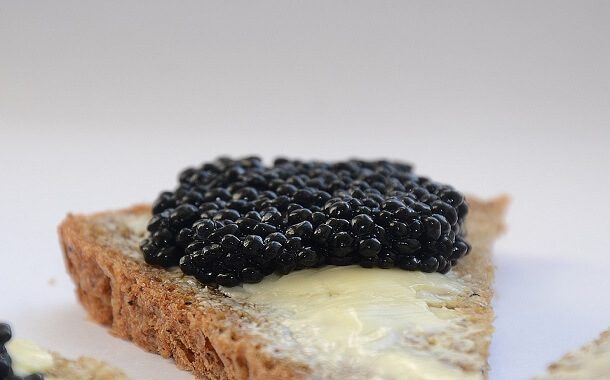How Much Does Caviar Cost?
Last Updated on December 27, 2023
Written by CPA Alec Pow | Content Reviewed by ![]() CFA Alexander Popinker
CFA Alexander Popinker
Caviar has been appreciated since ancient times. In the Roman Empire, a small amount of black caviar was worth as much as 100 sheep. Also, in Russia, Tsar Nicholas II allowed fishermen to pay their taxes in caviar.
Caviar is also called the black gold of international gastronomy. The largest caviar producers in the world are Russia and Iran.
Caviar is black roe from sturgeon. By salting, the black roe becomes caviar. The rarer the sturgeon species from which the roe come, the more expensive the caviar. In fact, rarity is the most important factor in the high price of caviar. The more difficult the product is to obtain, the more it is consumed by millionaires. For example, trout is a fish that makes roe every seven years. The best caviar from trout is harvested between 8 and 22 years old.
How much does caviar cost per ounce?
The average cost of caviar is anywhere between $55 and $3,100 for an ounce. The caviar price can vary due to many factors, including the geographical area, species, time of the year, rarity, quality, but also high demand.
As we already mentioned, the real caviar is harvested from sturgeons and we can choose from 26 species. However, the most common are Sterlet, Beluga, Sevruga, and Osetra caviar, the latter having a nutty flavor and creamy texture.
In the table below you will find the price estimates for the most popular species of caviar.
| Species | Cost Per Ounce |
|---|---|
| Sterlet | $90 |
| Siberian Sturgeon | $85 |
| Shovelnose | $60 |
| Sevruga Caviar | $120 |
| Pressed | $90 |
| Platinum Osetra | $375 |
| Paddlefish | $55 |
| Pacific Steelhead Roe | $85 |
| Pacific Salmon Roe | $100 |
| Pacific | $75 |
| Gold Osetra | $320 |
| Classic Osetra | $110 |
| Caspian Sea Beluga | $375 |
| Amur | $220 |
| Almas | $650 |
A substitute for real caviar is the Sturgeon roe. It is commonly found at local restaurants and is listed as beluga caviar. Its price is anywhere between $220 and $320 per ounce. The Paddlefish is a non-sturgeon and is also an alternative to real caviar. Its price is anywhere between $30 and $55 per ounce.
According to Serious Eats, you should budget around $55 to $80 for one ounce (30 grams), but the prices can be extremely high.
Bester Caviar Store reports that the price of albino sturgeon caviar can cost can range from $25 per ounce to over $78 per ounce, and $400 per pound, depending on the type of caviar.
For example, a Food Republic article noted that one of the most expensive caviar is harvested from a 60 to 100-year-old Iranian Beluga Almas Caviar and one ounce of it can be bought for almost $1,100.
A tablespoon of this expensive food can even reach $40,000. This most expensive caviar in the world is called Strottarga Bianco and is made from White Sturgeon roe.
Overall, the cost of true caviar can vary greatly depending on the type and quality of the caviar. The cost can range from $25 per ounce to over $113,000 per kilogram, depending on the vendor and the type of caviar. The rarity and prestige of caviar contribute to its high cost.
Types of caviar
Divided into four categories depending on the origin, the caviar has an imperceptible smell, and the roes have equal dimensions, shine, and do not stick together.
The golden caviar, also called royal, is the most appreciated and the most expensive category of black caviar, and, contrary to the name, it has the color of amber. Rare and difficult to obtain, this type of premium caviar comes from the sturgeon called sterlet.
You might also like our articles about the cost of unsalted butter, oysters, or the most expensive honey.
The second category, sturgeon caviar, is the most diverse, as it has a wide range of colors, sizes, and flavors. Sturgeons begin to produce caviar around the age of 12 when the eggs are very black with golden hues. With age, the eggs of this type of sturgeon lighten in color, and the taste becomes more delicate, making it a popular caviar.
The cod is the largest sturgeon and the only carnivore, but it is a very rare fish as well – every year about 100 cod are caught in the Caspian Sea. Cod caviar is appreciated for its large and perfectly separated caviar, with a color that varies from shades of gray to black. The most valuable are the light gray ones.
The most common category of black caviar is trout caviar, due to the fact that this fish is more common and makes caviar since the age of 7 years. The best trout caviar is harvested between 8 and 22 years old, is dark gray or black, and has a special taste, slightly saltier than other types of caviar.
Caviar overview
Sturgeon fishing is also strictly prohibited in most countries. However, it is found that illegal fishing and trade in sturgeon products continue. Control authorities have the power to remove illegal products from the market. Responsible and knowledgeable traders and consumers can also be careful not to buy caviar from sturgeon obtained by poaching, or from endangered species.
“Sturgeon populations have declined sharply in recent decades: poaching and the illegal wild caviar trade are the main threat to sturgeons,” says Jutta Jahrl, an expert on the caviar trade at WWF.
Wild-caught caviar is rare and expensive due to the intense regulations and the scarcity of sturgeon. Farm-raised caviar is more accessible and less expensive than wild-caught caviar.
What are the extra costs?
The experts recommend that you use a bone or pearl spoon to preserve the flavors of your caviar instead of metal.
Important things to consider
 Caviar is an important source of vitamins and minerals, but also omega 3, which helps keep the nervous, circulatory, and immune systems healthy. Caviar also contains other nutrients such as vitamins A, E, B6, iron, magnesium, and selenium.
Caviar is an important source of vitamins and minerals, but also omega 3, which helps keep the nervous, circulatory, and immune systems healthy. Caviar also contains other nutrients such as vitamins A, E, B6, iron, magnesium, and selenium.
Caviar can be purchased from different places. You can find it in hypermarkets, online, or in specialty stores. It should be noted that in hypermarkets, caviar is difficult to find given that it is quite expensive and not everyone can afford to buy it. So as not to waste time, you can search online or in specialty stores. This way, you can make sure that you do not waste time, you can choose the best quality, and in most cases, online stores deliver at home.
Preserved caviar can be stored outside the refrigerator until it expires. Once the can is opened, the caviar should be stored in the refrigerator.
If the caviar is not preserved, it can be stored in two different ways. If frozen, it can be stored in a freezer for three months. Once the caviar is thawed, it must be stored in a refrigerator in an airtight container.
Caviar should be stored at a refrigeration temperature of -35.6 degrees Fahrenheit. Fresh caviar can be stored in the refrigerator for 15-20 days (unopened). It is recommended to consume caviar a maximum of 2-3 days after it has been opened.
It was found that depending on the time you eat it and what you ate before, the same caviar has different tastes. And the best time to eat it is at 11 in the morning, after having a light breakfast a little earlier.
When you buy a box of caviar, there are some codes on its label that help you know more about its origin, regardless of the brand it bears. The group of three letters at the beginning indicates the sturgeon species such as BAE (from baeri), HUS (for species like beluga), and so on. This is followed by a C, which indicates that the fish was caught in captivity. There can also be a W on the label, which indicates it comes from wild-caught sturgeon.
How to serve the caviar delicacy
Caviar is eaten cold, never at room temperature.
It is never served on metal plates or with metal cutlery, as they are said to change its taste, making it bitter.
It would be ideal to serve it on a very cold crystal plate, with ceramic or glass utensils (crystal), to keep its taste. (in the United Arab Emirates it is served with 22-karat gold teaspoons)
The traditional label says that it is served in small portions, approximately the amount that fits in a teaspoon in a single sip.
Caviar is served as an appetizer, plain or on unsalted biscuits (greased with butter), on lightly toasted bread, or on a kind of Russian pancake called blini.
To add flavor and enjoy caviar, it can be garnished with fresh herbs (parsley or dill) and juice or thin slices of lemon.
Why is the price of caviar so expensive?
Caviar is considered a luxury delicacy, and is expensive due to a combination of factors:
Caviar comes from sturgeon, a fish that takes a long time to mature. Some species, like the Albino Beluga sturgeon, can take up to 20 years to reach maturity.
Over the years, overfishing has led to a significant decline in wild sturgeon populations, especially in the Caspian Sea, which was once the primary source of the world’s caviar production. This scarcity has driven up prices.
While sturgeon farming has become more common to meet demand and protect wild populations, it’s an expensive endeavor. Sturgeon requires specific conditions to thrive, and maintaining these conditions in a farm setting can be costly.
Caviar needs to be stored and transported under specific conditions to maintain its quality. This involves specialized packaging and rapid transportation, often by air, which also affects its price.
Caviar has a relatively short shelf life, even when refrigerated. This perishability means that it needs to be consumed quickly, which can add to its exclusivity and price.
Due to the decline in wild sturgeon populations, there are strict regulations in place for fishing and trading in the world of caviar, especially for certain species like the Beluga sturgeon. These regulations can limit supply and increase prices.
Caviar has long been considered a luxury item, enjoyed by royalty and the elite. This historical and cultural perception adds to its high value and price point.
The unique taste and delicate texture of caviar, combined with its rich nutritional profile, make it highly sought after, further driving up its price.
Only a few countries, such as Russia, Iran, and more recently, China, have the right conditions and expertise to produce it high-quality, limiting the global supply of caviar.
The caviar expensive cost is a result of its source, production challenges, regulations, and its esteemed status as a luxury food item.


Leave a Reply
Want to join the discussion?Feel free to contribute!